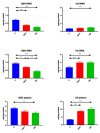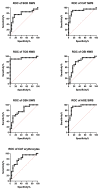Dysfunction of Salivary Glands, Disturbances in Salivary Antioxidants and Increased Oxidative Damage in Saliva of Overweight and Obese Adolescents
- PMID: 32079369
- PMCID: PMC7074099
- DOI: 10.3390/jcm9020548
Dysfunction of Salivary Glands, Disturbances in Salivary Antioxidants and Increased Oxidative Damage in Saliva of Overweight and Obese Adolescents
Abstract
Obesity is inseparably connected with oxidative stress. This process may disturb the functioning of the oral cavity, although the effect of oxidative stress on salivary gland function and changes in the qualitative composition of saliva are still unknown. Our study is the first to evaluate salivary redox homeostasis in 40 overweight and obese adolescents and in the age- and gender-matched control group. We demonstrated strengthening of the antioxidant barrier (superoxide dismutase, catalase, peroxidase, uric acid, total antioxidant capacity (TAC)) with a simultaneous decrease in reduced glutathione concentration in saliva (non-stimulated/stimulated) in overweight and obese teenagers compared to the controls. The concentration of the products of oxidative damage to proteins (advanced glycation end products), lipids (malondialdehyde, 4-hydroxynonenal) and DNA (8-hydroxydeoxyguanosine) as well as total oxidative status were significantly higher in both non-stimulated and stimulated saliva as well as plasma of overweight and obese adolescents. Importantly, we observed more severe salivary and plasma redox alterations in obese adolescents compared to overweight individuals. In the study group, we also noted a drop in stimulated salivary secretion and a decrease in total protein content. Interestingly, dysfunction of parotid glands in overweight and obese teenagers intensified with the increase of BMI. We also showed that the measurement of salivary catalase and TAC could be used to assess the central antioxidant status of overweight and obese adolescents.
Keywords: antioxidants; obesity; oxidative stress; saliva; salivary biomarkers.
Conflict of interest statement
The authors declare no conflict of interest.
Figures









Similar articles
-
Salivary gland dysfunction and salivary redox imbalance in patients with Alzheimer's disease.Sci Rep. 2021 Dec 13;11(1):23904. doi: 10.1038/s41598-021-03456-9. Sci Rep. 2021. PMID: 34903846 Free PMC article.
-
Salivary Antioxidant Barrier, Redox Status, and Oxidative Damage to Proteins and Lipids in Healthy Children, Adults, and the Elderly.Oxid Med Cell Longev. 2019 Dec 5;2019:4393460. doi: 10.1155/2019/4393460. eCollection 2019. Oxid Med Cell Longev. 2019. PMID: 31885792 Free PMC article.
-
Antioxidant Defence, Oxidative Stress and Oxidative Damage in Saliva, Plasma and Erythrocytes of Dementia Patients. Can Salivary AGE be a Marker of Dementia?Int J Mol Sci. 2017 Oct 20;18(10):2205. doi: 10.3390/ijms18102205. Int J Mol Sci. 2017. PMID: 29053628 Free PMC article.
-
Salivary and Urinary Total Antioxidant Capacity as Biomarkers of Oxidative Stress in Humans.Patholog Res Int. 2016;2016:5480267. doi: 10.1155/2016/5480267. Epub 2016 Feb 7. Patholog Res Int. 2016. PMID: 26966611 Free PMC article. Review.
-
Salivary Chemical Factors in Relation with Oral Cancer in Smokers and Non-Smokers: a Literature Review.J Dent (Shiraz). 2017 Dec;18(4):237-243. J Dent (Shiraz). 2017. PMID: 29201965 Free PMC article. Review.
Cited by
-
Salivary Biomarkers of Oxidative Stress and Inflammation in Stroke Patients: From Basic Research to Clinical Practice.Oxid Med Cell Longev. 2021 Apr 7;2021:5545330. doi: 10.1155/2021/5545330. eCollection 2021. Oxid Med Cell Longev. 2021. PMID: 33897941 Free PMC article. Review.
-
The Impact of Hypertension and Metabolic Syndrome on Nitrosative Stress and Glutathione Metabolism in Patients with Morbid Obesity.Oxid Med Cell Longev. 2020 Sep 9;2020:1057570. doi: 10.1155/2020/1057570. eCollection 2020. Oxid Med Cell Longev. 2020. PMID: 32963689 Free PMC article.
-
Salivary Redox Biomarkers in Insulin Resistance: Preclinical Studies in an Animal Model.Oxid Med Cell Longev. 2021 Sep 9;2021:3734252. doi: 10.1155/2021/3734252. eCollection 2021. Oxid Med Cell Longev. 2021. PMID: 34557264 Free PMC article.
-
Bariatric Surgery Normalizes Protein Glycoxidation and Nitrosative Stress in Morbidly Obese Patients.Antioxidants (Basel). 2020 Nov 4;9(11):1087. doi: 10.3390/antiox9111087. Antioxidants (Basel). 2020. PMID: 33158288 Free PMC article.
-
The Role of Antioxidants Supplementation in Clinical Practice: Focus on Cardiovascular Risk Factors.Antioxidants (Basel). 2021 Jan 20;10(2):146. doi: 10.3390/antiox10020146. Antioxidants (Basel). 2021. PMID: 33498338 Free PMC article. Review.
References
-
- WHO Global Database on Body Mass Index. [(accessed on 16 January 2020)]; Available online: http://www.who.int/bmi.
LinkOut - more resources
Full Text Sources

